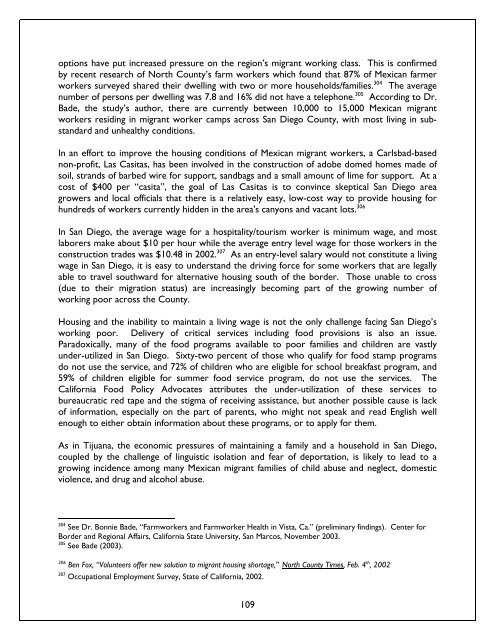Blurred Borders - International Community Foundation
Blurred Borders - International Community Foundation
Blurred Borders - International Community Foundation
Create successful ePaper yourself
Turn your PDF publications into a flip-book with our unique Google optimized e-Paper software.
options have put increased pressure on the region’s migrant working class. This is confirmed<br />
by recent research of North County’s farm workers which found that 87% of Mexican farmer<br />
workers surveyed shared their dwelling with two or more households/families. 304 The average<br />
number of persons per dwelling was 7.8 and 16% did not have a telephone. 305 According to Dr.<br />
Bade, the study’s author, there are currently between 10,000 to 15,000 Mexican migrant<br />
workers residing in migrant worker camps across San Diego County, with most living in substandard<br />
and unhealthy conditions.<br />
In an effort to improve the housing conditions of Mexican migrant workers, a Carlsbad-based<br />
non-profit, Las Casitas, has been involved in the construction of adobe domed homes made of<br />
soil, strands of barbed wire for support, sandbags and a small amount of lime for support. At a<br />
cost of $400 per “casita”, the goal of Las Casitas is to convince skeptical San Diego area<br />
growers and local officials that there is a relatively easy, low-cost way to provide housing for<br />
hundreds of workers currently hidden in the area's canyons and vacant lots. 306<br />
In San Diego, the average wage for a hospitality/tourism worker is minimum wage, and most<br />
laborers make about $10 per hour while the average entry level wage for those workers in the<br />
construction trades was $10.48 in 2002. 307 As an entry-level salary would not constitute a living<br />
wage in San Diego, it is easy to understand the driving force for some workers that are legally<br />
able to travel southward for alternative housing south of the border. Those unable to cross<br />
(due to their migration status) are increasingly becoming part of the growing number of<br />
working poor across the County.<br />
Housing and the inability to maintain a living wage is not the only challenge facing San Diego’s<br />
working poor. Delivery of critical services including food provisions is also an issue.<br />
Paradoxically, many of the food programs available to poor families and children are vastly<br />
under-utilized in San Diego. Sixty-two percent of those who qualify for food stamp programs<br />
do not use the service, and 72% of children who are eligible for school breakfast program, and<br />
59% of children eligible for summer food service program, do not use the services. The<br />
California Food Policy Advocates attributes the under-utilization of these services to<br />
bureaucratic red tape and the stigma of receiving assistance, but another possible cause is lack<br />
of information, especially on the part of parents, who might not speak and read English well<br />
enough to either obtain information about these programs, or to apply for them.<br />
As in Tijuana, the economic pressures of maintaining a family and a household in San Diego,<br />
coupled by the challenge of linguistic isolation and fear of deportation, is likely to lead to a<br />
growing incidence among many Mexican migrant families of child abuse and neglect, domestic<br />
violence, and drug and alcohol abuse.<br />
304 See Dr. Bonnie Bade, “Farmworkers and Farmworker Health in Vista, Ca.” (preliminary findings). Center for<br />
Border and Regional Affairs, California State University, San Marcos, November 2003.<br />
305 See Bade (2003).<br />
306 th<br />
Ben Fox, “Volunteers offer new solution to migrant housing shortage,” North County Times, Feb. 4 , 2002<br />
307<br />
Occupational Employment Survey, State of California, 2002.<br />
109















